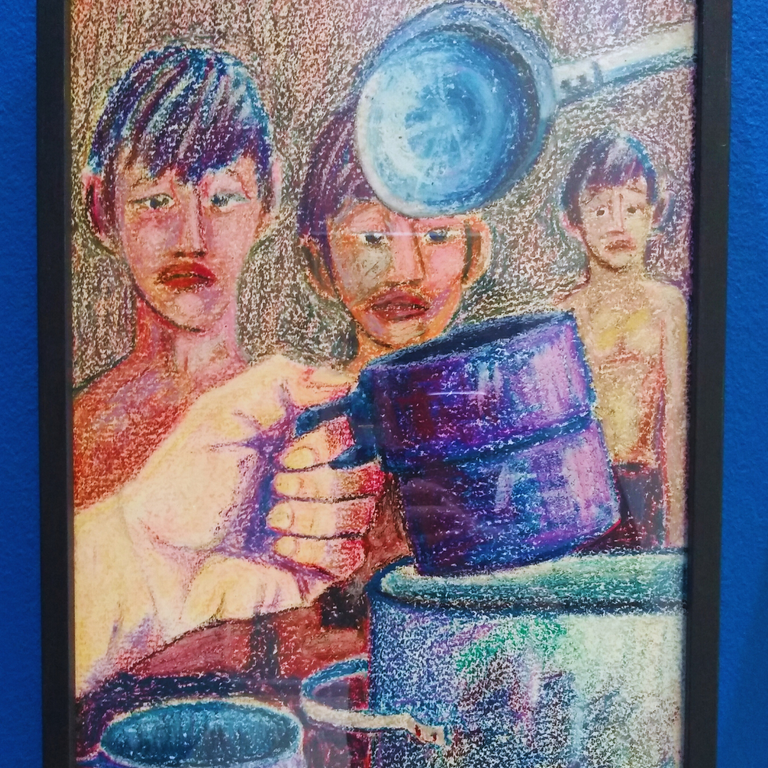Realismo y política en la obra de Carlos Pérez Turco / Realism and Politics in the artwork of Carlos Pérez Turco
Para todo ciudadano, verse mezclado con los temas de carácter social, siempre va a ser una realidad, inclusive aunque no tenga interés en tomar parte, pues ya con ello ha definido su posición.

En el caso de los artistas, pareciera que su relación es un tanto álgida, dada su forma diferente de percibir el mundo, pero también por el poco apoyo que suelen recibir por parte de los políticos, por lo menos, esa es la realidad en América latina.
Y es así como llegamos a la parte de la muestra de las obras seleccionadas del artista plástico Carlos Pérez Turco, exhibida en el centro cultural Leonardo Fabio de Lanús, en la que vemos ese lado de crítica y admiración hacia la realidad política que lo circunda, y nos permite conocer sus posturas con respecto a ello.

Por un lado, vemos la protesta silenciosa, plasmada en las necesidades de los ciudadanos que se encuentran al margen, quienes reciben dádivas a cambio de votos, pero que del resto son piezas ignoradas por los altos mandos.

De todas las que vi, estas dos piezas en particular me puse a pensar, que muchas de estas realidades no son cuestión de edades, sino de actitudes y más aún de decisiones. Mientras son jóvenes, buscan la salida fácil, y ya luego al envejecer dependen de una jubilación, cosas que no están mal, pero que si pensaran de otra manera, quizás esas realidades fueran diferentes.

Del lado idealista, vi una serie de retratos de líderes políticos de América del Sur, casi todos de la historia contemporánea, aunque Juan Domingo y Evita Perón se encuentran también entre ellos. Uno de ellos llamó mi atención, pero no por simpatía sino todo lo contrario.
Su ubicación a una altura más alta del nivel de los ojos de los visitantes, puede tener una doble lectura, ya que quizás buscaban resguardar las obras de algún ataque por parte de alguien opuesto a las ideas de quienes aparecen en ellos, o por el contrario, el obligar al espectador a subir la mirada, puede tomarse como una muestra de superioridad de los demás. Yo tomé partido por esta última idea.

Inclusive, la selección de personajes, ya muestra su inclinación política, al destacar solo aquellos de inclinación socialista, por lo que la presencia de Hugo Chávez fue la que me generó sentimientos encontrados.

Pero más allá de ello, he de reconocer que su arte está por encima de sus creencias y creo que así se debe tener que interpretar estas obras: parte real y parte ideal. Cada quien decide con cuál quedarse.

For every citizen, being involved in social issues will always be a reality, even if he or she has no interest in taking part, since he or she has already defined his or her position.
In the case of artists, it would seem that their relationship is somewhat strained, given their different way of perceiving the world, but also because of the little support they usually receive from politicians, at least that is the reality in Latin America.
And that is how we get to the part of the sample of selected works of the plastic artist Carlos Pérez Turco, exhibited at the Leonardo Fabio cultural center in Lanús, in which we see that side of criticism and admiration towards the political reality that surrounds him, and allows us to know his positions with respect to it.

On the one hand, we see the silent protest, embodied in the needs of citizens who are on the sidelines, who receive gifts in exchange for votes, but the rest are ignored by the higher-ups.

Of all the ones I saw, these two pieces in particular got me thinking, that many of these realities are not a matter of age, but of attitudes and even more of decisions. While they are young, they look for the easy way out, and then as they get older they depend on a retirement, things that are not bad, but if they thought differently, maybe those realities would be different.

On the idealistic side, I saw a series of portraits of South American political leaders, almost all from contemporary history, although Juan Domingo and Evita Perón are also among them. One of them caught my attention, but not out of sympathy, quite the contrary.
Its location at a higher height than the visitors' eye level, may have a double reading, as perhaps they sought to protect the works from some attack by someone opposed to the ideas of those who appear in them, or on the contrary, forcing the viewer to look up, can be taken as a sign of superiority of others. I took the latter idea.

Even the selection of characters already shows their political inclination, highlighting only those with socialist leanings, so the presence of Hugo Chavez was the one that generated mixed feelings in me.

But beyond that, I have to recognize that his art is above his beliefs and I believe that this is how these works should be interpreted: part real and part ideal. It is up to each one to decide which one to keep.
Foto/Photo by: @mamaemigrante. Créditos al artista Carlos Pérez Turco / Credits to the artist Carlos Pérez Turco.
Edición/Edited by @mamaemigrante using canva
Translated and formatted with Deepl
Congratulations @mamaemigrante! You have completed the following achievement on the Hive blockchain And have been rewarded with New badge(s)
You can view your badges on your board and compare yourself to others in the Ranking
If you no longer want to receive notifications, reply to this comment with the word
STOPCheck out our last posts:
Oye, pero qué difícil es decidir con quién quedarse...
🤔🤔🤔🤔
Yo no me quedaría con ninguno!